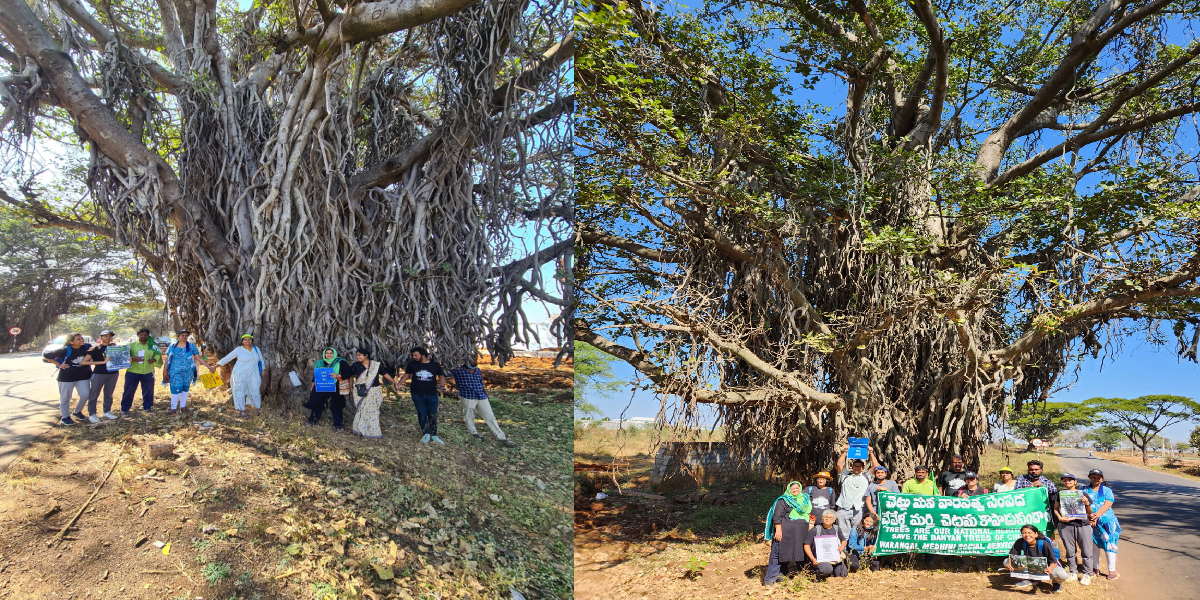However, the prime facie response is not factually adding up to the petitioners, who are now preparing a detailed response to debunk the claims of the NHAI before next NGT hearing.

Citizens lined up in front of the 'iconic' Banyan trees with huge trunks in Hyderabad, the winner of the 2022 World Green City Award. (Supplied)
Defending the project of widening the NH-163 highway, the National Highways Authority of India (NHAI) in its response to the National Green Tribunal (NGT) listed out all the reasons that require sacrificing over 700 Chevella banyan trees in Telangana.
As per sources, the NHAI counsel submitted the response on 10 January, Tuesday, the day before the date of the hearing scheduled on 11 January. But the Chevella banyans issue was later not listed by the NGT in its set of cases to be heard.
“We will go through the reply and file a detailed response. A new date will be sought for the next hearing,” Natasha Ramarathanam, the petitioner representing the Nature Lovers of Hyderabad (NLH), told South First.
Earlier, the ‘Save the Banyans of Chevella’ padayatra, an initiative of NLH, finished on 9 January in Hyderabad.
The 200 km walk from Warangal to Chevella (Hyderabad) by environmentalist Desam Kosam Prakash sought to prevent the felling of over 900 mature banyan trees across the 46 km stretch from Telangana Police Academy (Hyderabad) to Manneguda in Vikarabad district.
The city-based environmentalists claim that some of the banyans in Hyderabad, winner of the 2022 World Green City Award, are around 100 years old.
The NHAI said that after the NGT’s direction in the Chevella banyans issue, it explored several options, checked similar situations in the past, and the remedies adopted.
It added that it consulted experts for alternative routes and found that the number of banyan trees on the highway was “759 only” and not 1,036 as claimed by the NLH.
The NLH, in August last year, had said it geotagged as many as 914 banyan trees on the highway.
Meanwhile, for the 759 banyan trees, the NHAI observed that “only a few of them have a big trunk and huge branches” while about 90 percent are as good as any other tree (which can be translocated relatively easily).
Citing a previous example, the NGT attached pictures of translocated banyan trees on the Hyderabad-Srisailam highway and claimed that they had survived.
Calling translocation of the banyan trees of Chevella as the best alternative, the NHAI added that leaving them on the highway would reduce their lifespan due to vibrations and sound pollution.
Meanwhile, naturalist Kobita Das had earlier viewed translocation as inadvisable for such old and valuable trees.
“What is moved at the end of the translocation of a tree — after cutting branches, trimming roots, treating these with chemicals, and killing its soul — is most often a stump with a few branches and leaves,” she had told South First.
Drawing attention to the Central Vista Project in national capital Delhi, Ramarathanam had told South First that only 27 percent to 30 percent of trees there survived after a year.
The NHAI, in view of the heavy traffic, submitted the data on accidents on the NH-163 Chevella road under the Cyberabad commissionerate and ruled out the restriction of stretch and width of the highway.
As per the data given by the NHAI, 802 fatal and non-fatal accidents occurred on the highway between 2018 and August 2022, including 321 deaths.
It also denied the possibility of constructing a parallel road without bothering the trees, claiming that the “entire road has a serpentine shape and most of its neighbouring area is either in catchment or forest area”.
According to the NHAI, the acquisition of more land is not possible due to legal issues.
Meanwhile, an estimated 9,000 trees are expected to be affected along the route.
Part of the Union government’s infrastructure development plan, the project seeks to widen the existing seven-metre-wide two-lane road to a four-lane road at an estimated cost of ₹956 crore.
For the NLH petitioners, there are several aspects to the NHAI submission that require a detailed response.
Teja Balantrapu, one of the petitioners, explained to South First, “The NHAI claims that nearly 90 percent of the banyans are the same size as other trees for translocation. However, in our publicly available geo-tagging dataset, about 18 percent of the trees (168 trees in total) are iconic with large trunks, full canopies, and extensive prop roots. Nearly 650 trees (70 percent) have extensive prop-roots.”
He added that the NHAI’s claim that the trees are bereft of life due to noise pollution is untrue.
“We have noted many bird and animal species on these trees and others can too if they spend an hour or two under them,” he claimed, adding that the NLH will be soon filing a detailed response to debunk the NHAI’s claims.
Teja, also a member of the NLH, claimed, “The traffic data is not actual, they are projections from 2015. So we need to unpick the math there a bit.”
“We all want an expanded road, but we want a good argument for the choices the NHAI makes along with a detailed and extensive process,” he added.

Apr 29, 2024

Apr 28, 2024

Apr 28, 2024

Apr 28, 2024

Apr 28, 2024

Apr 28, 2024